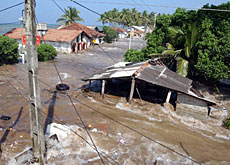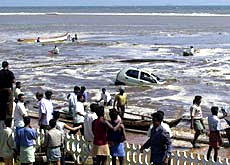Tsunami threaten even landlocked Swiss

A leading Swiss wave specialist has warned that predicting the effects of giant waves, such as the Indian Ocean tsunami, will remain difficult.
Willi Hager says not just earthquakes but also volcanoes and landslides can trigger tsunami, and even Switzerland could be at risk.
The best way of avoiding huge death tolls in the future will be to educate and provide shelters for people, argues Hager.
The head of hydraulic research at the Federal Institute of Technology in Zurich says that the effects of the earthquake off Sumatra on December 26 could not have been foreseen.
“We simply cannot tell how big the waves generated by a tremor will be,” he told swissinfo.
“What we do know is that when there is an earthquake in or by the sea there will almost always be waves, something a lot of people failed to understand a few weeks ago.”
Hager says that it is impossible to come up with a precise experimental or numerical model of a tsunami’s behaviour. He adds that factors such as scale or coastline variations make any prediction difficult.
Education and shelter
Many experts are now calling for a tsunami early-warning system in the Indian Ocean region to avoid a repeat of last month’s disaster.
Hager agrees that such a system would be a step in the right direction, but says that there are other ways of mitigating the effects of killer waves.
“We should educate children in coastal regions about the dangers of tsunamis to start with,” he said. ” People have to realise that an earthquake might do some damage, but that huge waves may be on the way in a short time.”
The Swiss researcher adds that the tourism industry could help protect people, especially the local population, by offering shelter in zones that could be affected by tsunami.
“This could be hotels along the shoreline with a high standard of construction that would make them earthquake- and tsunami-proof,” he said. “People should be able to seek refuge on the upper floors of these establishments.”
Hager says that although tsunami lose much of their height when they hit the shore, they still retain the capacity to cause huge damage. “This is why people have to put themselves out of reach if they can,” he added.
Swiss threat
Besides earthquakes, there are two other ways of generating huge waves: volcanic explosions and landslides.
While undersea tremors and volcanoes can be ruled out in Switzerland, an avalanche or a rockfall in the wrong place could generate a giant wave.
“There are many large water bodies here, especially dam reservoirs, where large landslides or avalanches can have an impact,” said Hager.
While this has never happened in the Swiss Alps, an underwater earthquake in Lake Lucerne 400 years ago triggered huge waves which left the city of Lucerne under water. And nearly 40 years ago, a huge landslide into an Italian dam reservoir created a wave that killed around 2,500 people.
Hager’s research focuses on these so-called impulse waves and how to mitigate their effects. His team recently studied the effects of a landslide at Alaska’s Lituya Bay in 1958.
The wave generated was so big that it ran over 500 metres up a hill on the other side of the fjord, removing trees and soil along the way. Fortunately, the region is uninhabited and only two boaters were killed.
The Swiss scientists were able to simulate the landslide in one of the world’s best test tanks, with results remarkably similar to observations carried out in Alaska.
Flooded cities
While a tsunami is less likely in Switzerland, even cities like Zurich could end up being flooded.
“The Sihlsee dam near Einsiedeln, which was designed in the 1930s, could release a large wave towards the city,” Hager told swissinfo.
“Any damage would probably occur around the main station, but most of the buildings are strong enough to resist any such wave.”
The wave specialist adds that the chances of somebody losing their life in such a case is low.
“Most people don’t realise we test our flood alarms twice a year, and even if something did happen, there should be enough time to get out of harm’s way.”
swissinfo, Scott Capper
Tsunamis are formed by a displacement of water by a landslide, volcanic eruption or earthquake.
The December 26, 2004 tsunami was caused by an earthquake along the boundary between two tectonic plates.
Tsunamis can travel at up to 965 km per hour at the deepest point of the water, but slow to 48 to 64 km per hour as they near the shore.
The energy of the wave’s speed is then transferred to height and sheer force.

In compliance with the JTI standards
More: SWI swissinfo.ch certified by the Journalism Trust Initiative










You can find an overview of ongoing debates with our journalists here . Please join us!
If you want to start a conversation about a topic raised in this article or want to report factual errors, email us at english@swissinfo.ch.